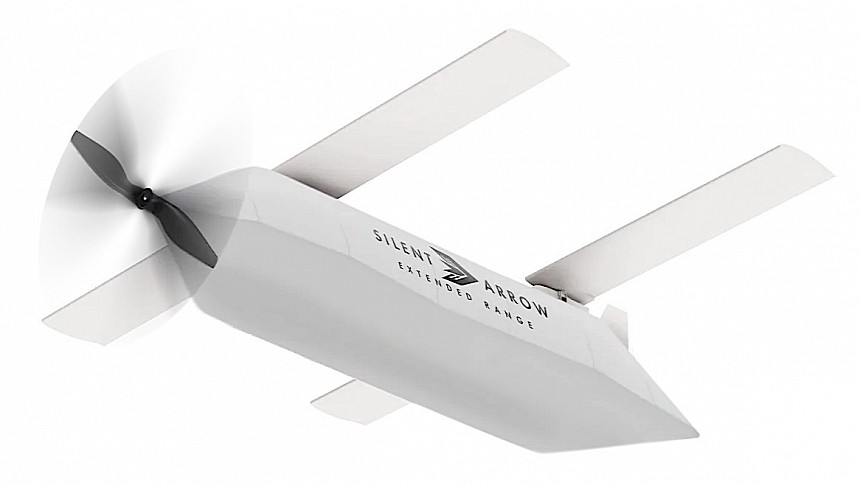For the most part of their existence military drones have been used for military action or surveillance. In recent years, however, the focus has shifted towards cargo-carrying needs because drones are seen as the perfect tools to get much-needed supplies in contested areas.
It's not exactly clear if any of the world's militaries are already using such purpose-built drones, but we do know for a fact America is investing heavily in the research of such technologies, and it plans to rely on them heavily over the coming decades.
Because of the nature of the work in this field we do not have a complete picture of what research is being conducted by whom and where, but we learned of yet another piece of the puzzle falling into the right place this week.
A company called Silent Arrow announced it was selected by the U.S. Air Force (USAF) to develop an air-dropped cargo drone that can carry 1,000 pounds (454 kg) of payload for distances that can go to as far as 345 miles (555 km).
Silent Arrow was created in 2012, and at the time of writing it makes "autonomous cargo delivery aircraft." There are four different drones the company is offering at the moment, each capable of carrying between 350 and 2,000 pounds (160 to 900 kg) of cargo. That can be any kind of supplies needed for emergency, disaster relief and humanitarian response.
It's a type of drone called GD-2000 that's of interest to us now. Described by its maker as "the world's first heavy payload, autonomous and attritable cargo delivery aircraft" it can carry 1,500 pounds (680 kg) of supplies over a distance of 40 miles (64 km).
The thing works by being dropped from an airplane, including the military Lockheed Martin C-130, Boeing C-17, and Airbus A400M, and it then glides down to its target, as it has no means of propulsion.
The GD-2000 will spawn the so-called Contested Logistics System, 300 Nautical Miles system for the U.S. Air Force. CLS-300 for short, it will be fitted with "an innovative propulsion unit and propeller system" that should ensure ten times more range than the drone it is based on.
It too will be suitable to be air-dropped, but thanks to the yet undisclosed powertrain, it will also have the capability to take off from the ground, even from unprepared surfaces and also from ships at sea.
The company plans to run the first propulsion tests for the drone in the first half of next year, and has flight tests in mind for the second half. The USAF did not make any mention as to when it expects the CLS-300 to be ready for military duty, and there's also no guarantee it will actually go for it.
Because of the nature of the work in this field we do not have a complete picture of what research is being conducted by whom and where, but we learned of yet another piece of the puzzle falling into the right place this week.
A company called Silent Arrow announced it was selected by the U.S. Air Force (USAF) to develop an air-dropped cargo drone that can carry 1,000 pounds (454 kg) of payload for distances that can go to as far as 345 miles (555 km).
Silent Arrow was created in 2012, and at the time of writing it makes "autonomous cargo delivery aircraft." There are four different drones the company is offering at the moment, each capable of carrying between 350 and 2,000 pounds (160 to 900 kg) of cargo. That can be any kind of supplies needed for emergency, disaster relief and humanitarian response.
It's a type of drone called GD-2000 that's of interest to us now. Described by its maker as "the world's first heavy payload, autonomous and attritable cargo delivery aircraft" it can carry 1,500 pounds (680 kg) of supplies over a distance of 40 miles (64 km).
The thing works by being dropped from an airplane, including the military Lockheed Martin C-130, Boeing C-17, and Airbus A400M, and it then glides down to its target, as it has no means of propulsion.
The GD-2000 will spawn the so-called Contested Logistics System, 300 Nautical Miles system for the U.S. Air Force. CLS-300 for short, it will be fitted with "an innovative propulsion unit and propeller system" that should ensure ten times more range than the drone it is based on.
It too will be suitable to be air-dropped, but thanks to the yet undisclosed powertrain, it will also have the capability to take off from the ground, even from unprepared surfaces and also from ships at sea.
The company plans to run the first propulsion tests for the drone in the first half of next year, and has flight tests in mind for the second half. The USAF did not make any mention as to when it expects the CLS-300 to be ready for military duty, and there's also no guarantee it will actually go for it.







